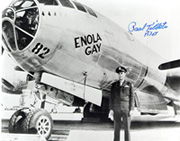Enola Gay
Teacher Page
In this type of assignment students
investigate whether a particular event, person or
development is of historical significance and why.
The answer to that question may be very different and
depends on the chosen criteria.
In all these assignments, students may use a given set of
criteria to answer the questions, but of course they can
use other criteria as well, for example their own
criteria.
This assignment is of course only
appropriate when and if the students have a reasonable
(context) knowledge of the second world war and the cold
war.
Criteria
Events and developments
1. Time
-
was the event or development important to contemporaries?
-
was the event or development important to to people in the years/ages after the event/development?
-
is the event or development important for the present?
-
is the event or development important for the future?
Note
Regarding the latter two criteria Christine Counsell (2004) refers to the danger of presentism. The danger is that the historical significance is only measured by its importance for the present.
2. Quantity
-
how many people are involved in the event or development?
-
did the event had an impact on society for a long period of time?
3. Quality
-
how influential was the event/development in the short and long term?
-
did the event/development influence other developments?
-
did the event/development lead to (radical) changes in society?
-
was the event/development a turning point / milestone in history?
Persons
Part of these criteria can be (somewhat modified) used in assessing the historical significance of people.
1. Time
-
was the person (what the person did) important to contemporaries?
-
was the person (what the person did) important to to people in the years/ages after the event/development?
-
is the person (is what the person did) important for the present?
-
is the person (is what the person did) important for the future?
2. Quantity
-
did the person (what the person did) had a long term impact on society ?
3. Quality
-
did the person (what the person did) had an (long term/ short term) impact on society?
-
did the work of the person lead to (great) changes in society?
-
did the (work of the) person influence influence developments in society?l
-
did the work of the person had an impact on other people's quality of life?
-
was the person an example to other people?
If you think judge this assignment to be rather
difficult, you
might want to give the students some preliminary tasks:
Hier nog een link naar een pagina over omgaan met bronnen.
A criminal act?
John Pilger said, in the Guardian in 2008, that the dropping of atomic bombs was a criminal act. A challenging stand for a discussion with the class.
‘The atomic bombing of Hiroshima and Nagasaki was a criminal act on an epic
scale. It was premeditated mass murder that unleashed a weapon of intrinsic
criminality. For this reason its apologists have sought refuge in the mythology
of the ultimate “good war”, whose “ethical bath”, as Richard Drayton called it,
has allowed the west not only to expiate its bloody imperial past but to promote
60 years of rapacious war, always beneath the shadow of The Bomb …
John Pilger in the Guardian, August 8, 2008

Copyright: Albert van der Kaap, 2011
